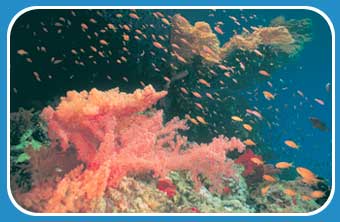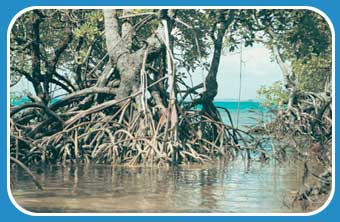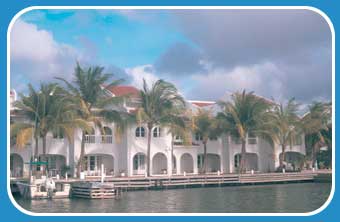| |
The coastlines of St Lucia contain particularly rich and varied marine resources, including coral reefs, mangrove forests, a diversity of fish, and beach habitats. The island's marine ecosystems are very valuable to people. Part of their value lies in their biodiversity but part also results from the way in which these ecosystems offer opportunities for sustainable economic development.
Coral reefs
Coral reefs are often thought of as 'the rainforests of the sea' on account of the huge number of species they contain. But like tropical rainforests, the complex inter-relationships between the many different species that inhabit a coral reef make the ecosystem very sensitive to disturbance.

©Rafel Al Ma'ary/Still Pictures.
|
Coral reefs shelter more than 25 per cent of all known fish species even though they occupy less than 0.25% of the world's marine environment. |
A 1998 survey showed that 65% of coral reefs in the Caribbean were in danger, and the coral reefs along St Lucia's west coast are no exception.
 to find out how people can damage coral reefs. to find out how people can damage coral reefs.
The Soufrière Marine Management Area
Nevertheless, protecting reefs makes sound economic sense as well as environmental sense. Good management can produce booming and sustainable fish yields. Money could be made from tourists who want to visit the coral reefs as well.
Since 1986, the St Lucia government's Department of Fisheries and Department of Tourism, local tourism organisations and the Soufrière Regional Development Foundation have worked together to prevent the further destruction of this valuable marine environment. They have set up the Soufrière Marine Management Area (SMMA), a 12 km stretch of coastline. Six sections of the SMMA are now marine reserves and fishing priority areas were established in another three sections.
Managing the SMMA is not always easy. Conflicts can arise as different people want to use the area in different ways; for example, tour operators and local fishermen. To ease these conflicts, the people affected are encouraged to exchange their views in meetings, and to actively participate in the future planning and management of the area.
Mangrove ecosystems
| St Lucia's coral reefs also depend on the health of another marine ecosystem, the mangrove forests. Mangrove trees are adapted to the conditions along tropical coasts where fresh water mixes with salt water. A dense network of roots spread out from the mangrove trees, sticking out of the water to take in oxygen. |

©Simon Scoones/Worldaware. |
The main area of mangrove forests in St Lucia is at Mankote in the south-east of the island. Up until the 1960s, Mankote was used as a US airbase. As access to the area was limited, there was very little destruction of the surrounding mangroves. However, once the base closed, the mangrove forests were opened up for fishing, hunting and as dumping grounds for waste by local people. Another important use of the mangroves at Mankote was for the production of charcoal as a source of fuel in the nearby town of Vieux Fort, home to 15,000 people.

©Garrett Nagle. |
In some places, mangrove forests have been completely removed to make way for tourism developments. |
The Caribbean Natural Resources Institute (CANARI), an association between local businesses and governments, has developed a plan for the sustainable use of Mankote. CANARI has protected the rights of charcoal producers to use the area. But to ensure that the mangroves are not plundered for short-term gain, charcoal producers now use only a small amount of wood at any one time, allowing the mangrove trees to re-grow. This way, the mangrove ecosystem has a better chance of being preserved for future generations.
|
|





